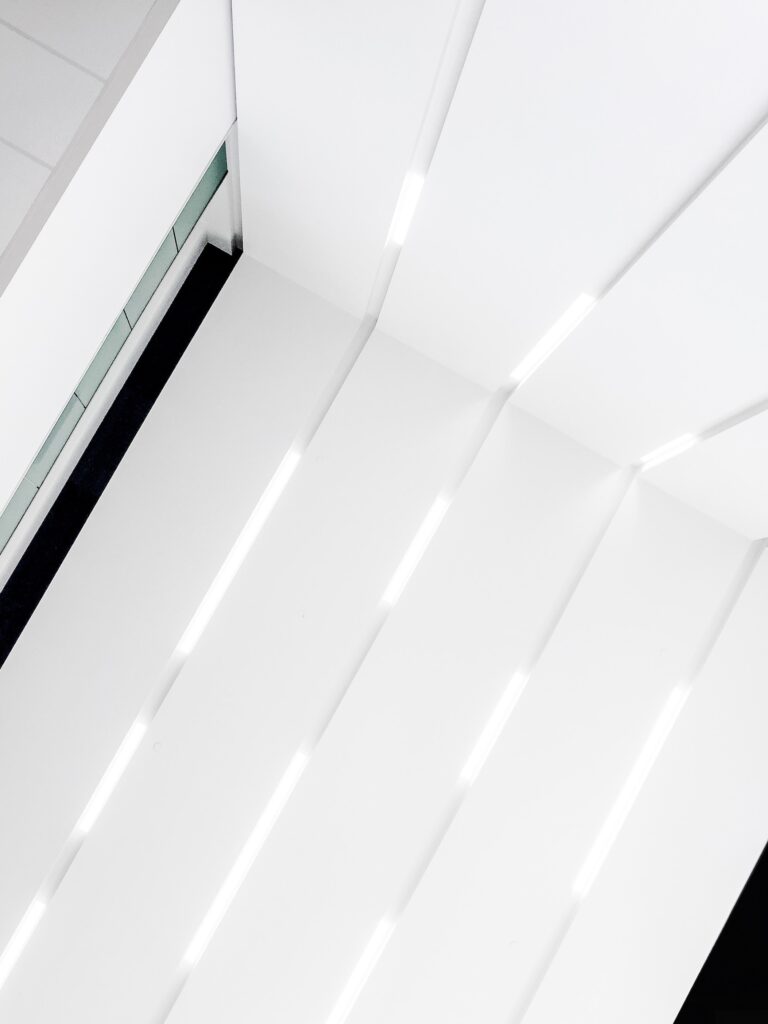Your home is a creative canvas, and the fifth wall (your ceiling) presents untapped design potential. The right ceiling design can transform a mundane space into something truly exceptional, evoking a sense of wonder and luxury.
“Sky’s the limit” is more than a phrase when it comes to ceiling interior designs. It’s an invitation to explore innovative ceiling design ideas that can turn your dream home into a reality.
This article will delve into the art of ceiling design, exploring various textures, materials, lighting options and trends that can elevate your interior spaces. From coffered ceilings to exposed beams, minimalistic elegance to daring splashes of colour, we’ll show you how to make the most of your fifth wall. By the end, you’ll be inspired to create a lush and mesmerising home that reflects your unique style and taste.
Let’s reach for the stars and reimagine your ceiling into a man-made heaven for your interiors!
Choosing The Right Ceiling Materials
Ceiling materials significantly affect any room’s aesthetic and functionality. Each type of material has its own set of pros and cons, which can influence your ceiling design choice.
Gypsum Board (Drywall)
Pros: Gypsum board is a common choice due to its affordability, ease of installation, and versatility. It can be easily painted and provides a smooth, seamless appearance when finished properly. It’s also a good choice for concealing wiring and providing a clean canvas for various ceiling treatments.
Cons: Gypsum board is susceptible to water damage, making it less suitable for high-moisture areas. It may develop cracks over time, and its plain appearance might add minimal character to a room.
Wood
Pros: Wooden ceilings exude warmth and charm, which are excellent additions to rustic and traditional spaces. They offer outstanding acoustic properties and can be stained or painted in different finishes.
Cons: Wood ceilings are expensive. They also require regular maintenance to prevent warping, cracking, or discolouration. They might not be ideal for humid environments.
Tin
Pros: Tin ceilings are prized for their vintage appeal and intricate designs. They are durable and fire and moisture-resistant. Their versatility allows them to accentuate the look of many rooms, including kitchens and bathrooms.
Cons: Tin ceilings can be costly, and their installation is more challenging. They can also be quite reflective, potentially affecting lighting in a space.
Plaster
Pros: Plaster provides a timeless, elegant look and offers superior soundproofing qualities. It can be moulded into numerous shapes and patterns, adding ornate detailing to a room.
Cons: Plaster ceilings can be expensive and labour-intensive to install. They are susceptible to cracking and may require frequent professional repair. Additionally, plaster is heavy, requiring strong ceiling support.
Selecting the right ceiling material should be based on your design preferences, budget, and the room’s specific needs. Consider these pros and cons to make an informed decision that suits your interior design project.
Illuminate Your Fifth Wall: Lighting Options
Proper lighting can help you achieve your desired ambience, highlight architectural features, and improve room functionality. Here are some different lighting options that can enhance your ceiling interior:
Recessed Lighting
Recessed or can lights are discreet and versatile, fitting seamlessly into the ceiling. They even out the room’s illumination, making them ideal for general and task lighting. You can strategically space them out to effectively highlight significant aspects of a room.
Chandeliers
One instantly associates chandeliers with sophistication and grandeur. These exquisite fixtures can serve as the room’s focal point, making it an instant conversation starter. They offer ambient and decorative lighting and come in various styles to suit different preferences.

Pendant Lights
Pendant lights hang from the ceiling, adding visual interest and task lighting to specific areas, such as kitchen islands or dining tables. Their wide range of designs makes them appropriate for multiple interior styles.
Cove Lighting
If you want more discreet lighting, cove lighting is perfect for you. This involves hidden LED strips or fixtures installed in a recess or ledge around the room’s perimeter. It creates a soft, indirect glow that adds depth and warmth to a space.
Track Lighting
If you have artwork or architectural elements you want to highlight, track lighting is ideal. It allows you to adjust the direction of individual fixtures.
Flush Mounts and Semi-Flush Mounts
These fixtures are close to the ceiling and come in various designs, providing ambient lighting while keeping a low profile.
LED Panels
LED panels are flat, energy-efficient light sources that you can integrate into the ceiling itself for a modern, streamlined appearance.
Skylights
For natural light, consider adding skylights to your ceiling. They provide illumination while connecting you to the outdoors.
When incorporating these lighting options into your ceiling design, it’s important to consider the room’s purpose, the desired atmosphere, and your space’s overall aesthetic. By blending different lighting sources, you can create a layered and inviting environment that meets your needs and style.
The Popularity of Trends in Ceiling Designs
Ceiling design trends are ever-evolving, reflecting shifts in architectural styles, interior aesthetics, and technological advancements. Here are some current and upcoming trends in ceiling design that ensure your space looks modern and stylish:
Minimalist Elegance
Contemporary interior design often leans towards minimalism. Smooth, unadorned ceilings with clean lines and subtle finishes promote simplicity and spaciousness, making them a popular choice for those seeking a sleek, modern look.
Coffered Ceilings
The timeless charm of coffered ceilings endures to be a sought-after trend. The intricate grid pattern adds depth and architectural interest, making it an excellent choice for traditionally styled homes and upscale spaces.
Rustic Exposed Beams
The rustic design trend embraces exposed wooden beams on ceilings. Whether you have a farmhouse or industrial aesthetic, these beams bring a historical touch and warmth to a room.
Colourful Ceilings
More daring homeowners opt for colourful or contrasting ceilings. This trend involves using bold paint colours or intricate patterns to draw attention upward and create an interesting focal point in the room.
Smart Lighting Integration
As smart home technology advances, integrating lighting into ceilings has become a popular trend. Recessed, controllable LED lights and programmable lighting schemes allow homeowners to adjust the ambience easily.
Acoustic Ceilings
In residential and commercial spaces, acoustic ceiling solutions are gaining popularity. These designs improve sound insulation and audio quality, making them ideal for home theatres and open-concept spaces.
Keeping an eye on ceiling design trends can help you stay current and inspired when planning your interior renovations. It’s important to blend these trends with your style and your home’s characteristics for a space that feels authentic to you.
Invigorate Your Space with Inspired Ceiling Designs
Ceilings are often overlooked, but they are essential for elevating your living space. From coffered ceilings to smart lighting, the possibilities are endless.
Your choice of ceiling material, texture, lighting, and design trends are instrumental in creating an atmosphere that reflects your preferences. Whether it’s the timeless allure of exposed beams, the clean lines of minimalism or the dramatic statement of colourful ceilings, your choice influences your home’s atmosphere.
So, aim for the fences and let your ceiling design aspirations soar. Here’s your sign to create a whimsical haven where every time you look up, you’re greeted by an artistic masterpiece above.




